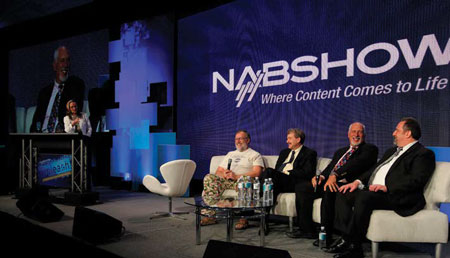NAB Show Panel Debates 4K Future
At the NAB Show Super Session “4K, UHD, HDR and More: The Future of Video” panelists discussed various aspects of the enhanced video landscape and how to invest for the future.
Moderated by TV Technology Executive Editor Deborah McAdams, the panel consisted of James DeFilippis, CGO for TMS Consulting; Matthew Goldman, senior vice president for technology, TV and media strategy for Ericsson; Mark Schubin, chief information server for SchubinCafe.com; and Robert Seidel, SMPTE president and vice president of engineering for the CBS Television Network.

(L to R): Deborah McAdams, Mark Schubin, Robert Seidel, James DeFilippis and Matthew GoldmanBEST BANG FOR THE BIT
From the beginning, the panelists generally discounted the interest in 4K in favor of improvements to HD video by using high dynamic range, wide color gamut and high frame rate techniques.
The reasons for improving HD and not jumping into 4K are compelling, each of the panelists said.
“If you push this technology too far, there are consequences,” Seidel said. One of the limiting factors for advancing 4K is cost.
“We say, ‘What’s the best bang for the buck,’ but at the end of the day, that comes down to, ‘What’s the best bang for the bit,’” Goldman said. “When you look at the cost of bandwidth and the cost of current infrastructures, given a choice of all these technologies, I’d like to have them all. Unfortunately, going four times the resolution in a plant where people are just upgrading to 3 Gbps, you need four times that. Even in the compressed domain it takes two to 2.5 times the bits to do that.
“If you look at the biggest bang, and I’m talking about the ‘wow-factor’ for the consumer, independent viewing confirms that nothing works better than a properly done high dynamic range,” Goldman said. “It’s a combination of three factors: high dynamic range, wider color gamut and 10-bit sampling bit depth — the three of those together make a really ‘wow’ impact.”
Goldman noted that those three improvements in 1080p HD could be made with just a handful of bits, and it makes a difference that can be seen from across the room. That compares to the resolution improvement of 4K alone, which can be seen only within a two-screen-height distance from the display.
TOO MUCH INFORMATION?
At the Future of Cinema conference just prior to the show, Ang Lee previewed his upcoming film “Billy Lynn’s Long Halftime Walk,” that was shot in 4K 3D and at 120 fps. Seidel said that it presented a heightened sense of reality that some in the audience found jarring.
“Maybe that’s just a matter of getting the audience accustomed to a new look,” he said. “It was a totally different experience.”
DeFilippis said that a study he worked on at Baylor University regarding high frame rates showed that the hyper-realistic effect would manifest itself only on larger displays.
“On relatively small screens—30 inches, 40 inches, and maybe even as much as 50 inches—high frame rate does not have much visual impact,” he said.
Schubin mentioned an article that will appear in an upcoming issue of the SMPTE Journal stating that factors such as high dynamic range, wide color gamut and frame rates interact with each other.
“We’re all talking about how wonderful high dynamic range is, but high dynamic range makes motion artifacts more visible,” he said. “If you just go to high dynamic range and you’re at 24 fps, then you’re making the motion look worse.”
So which technology can realistically be integrated into the production and broadcasting workflow first? As the discussion went on, HDR, WCG and higher resolution all had significant concerns, especially when making them compatible with millions of existing TVs.
“There’s a concept of ‘shoot-and-protect,’” Goldman said. “You shoot it in HDR, but maybe you do something a little different so that you know when you convert it to standard dynamic range you can maintain [a good image].”
Goldman pointed out that there are no standards for integrating any of these into the current broadcast workflow and the soonest there may be relevant standards would be the end of 2016.
Meanwhile, consumers are buying 4Kcapable displays and some of them are watching 4K programming from providers such as Netflix. As more consumers buy into the promise of 4K, there will be increasing pressure on regulators and broadcasters to make 4K broadcasting a reality.
The panelists reiterated that 4K was simply not the first improvement that should be upgraded in the broadcast workflow. The final word seemed to be that we need to wait until more standards are in place to maximize compatibility and picture quality.
Get the TV Tech Newsletter
The professional video industry's #1 source for news, trends and product and tech information. Sign up below.
Bob Kovacs is the former Technology Editor for TV Tech and editor of Government Video. He is a long-time video engineer and writer, who now works as a video producer for a government agency. In 2020, Kovacs won several awards as the editor and co-producer of the short film "Rendezvous."

